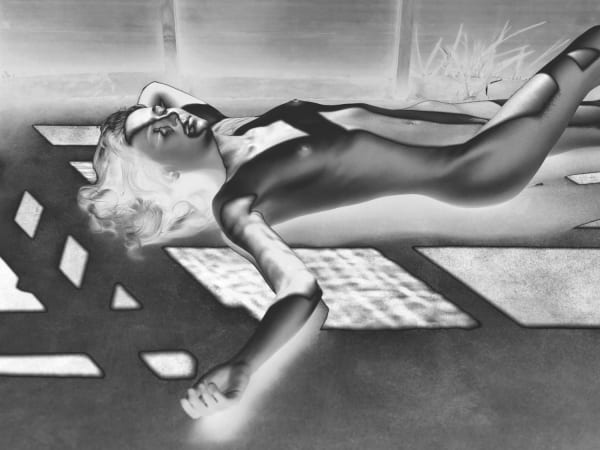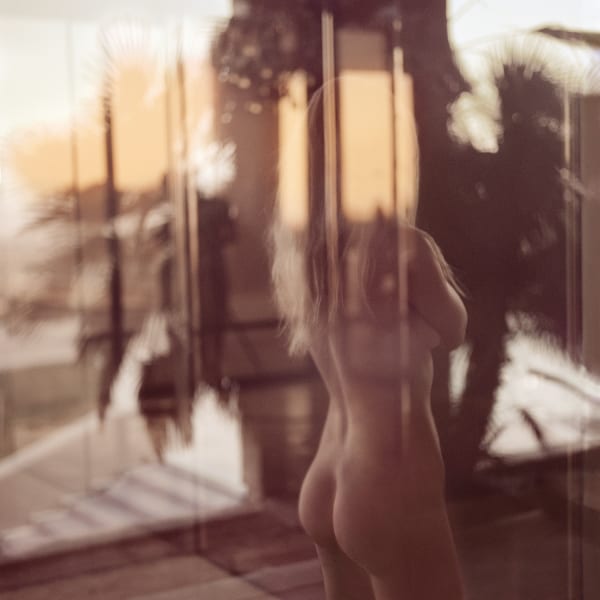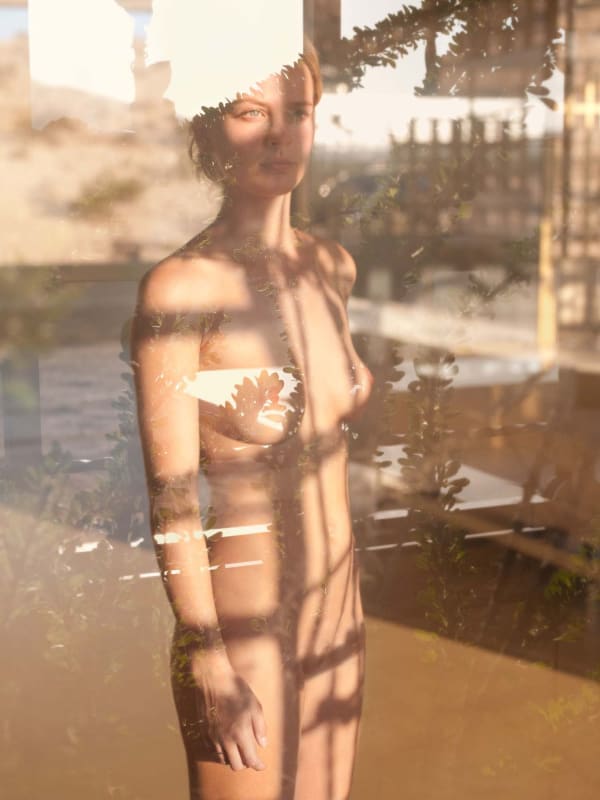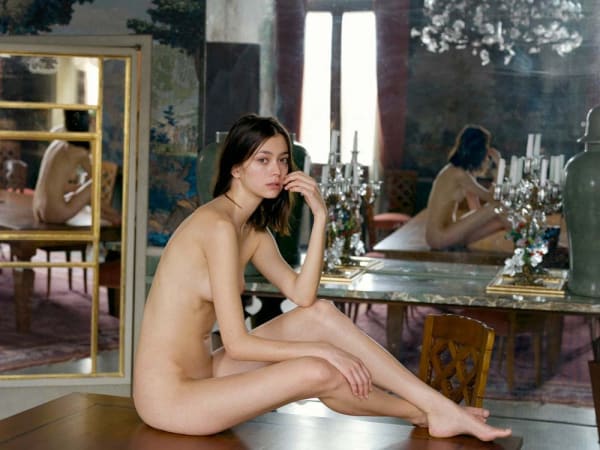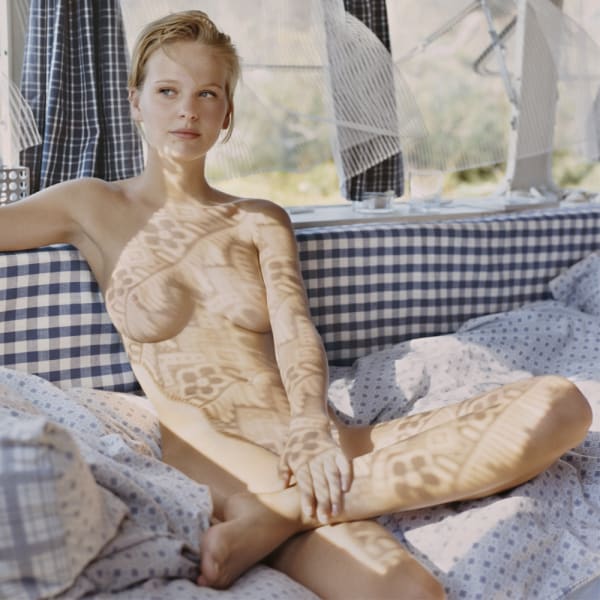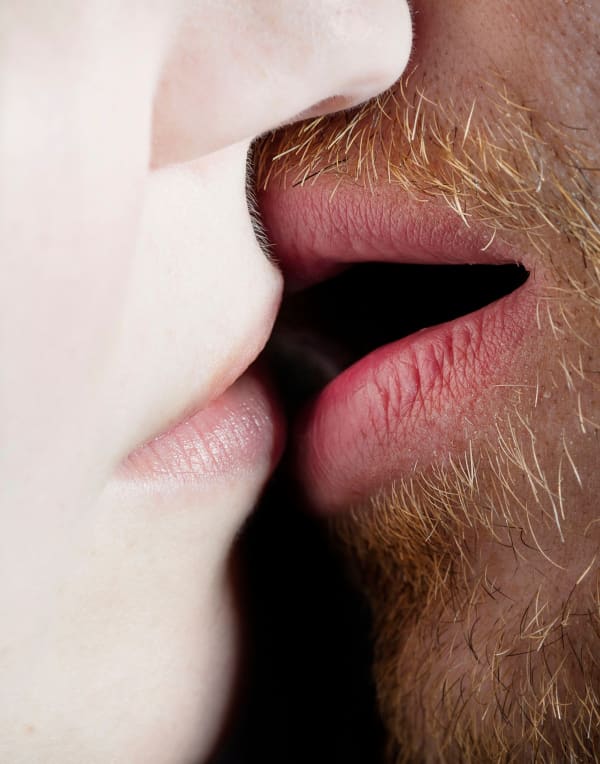Mona Kuhn
Dream-like and ethereal, Mona Kuhn’s artwork synthesizes portraiture, landscape, and abstract imagery to contemplate the human body in its most natural state. The artist is known for her portrayals of the human figure, creating images that exude warmth, comfort, and beauty. The subjects’ settings mirror or complement their organic postures outdoors, whether they are sun-drenched in the southern California desert, lush French landscapes, or indoors.
Kuhn’s creative process begins with a color palette and emotion, before the artist identifies a location and finally her subjects. Her 2006 series Evidence, amongst the first bodies of work to earn the artist acclaim, is comprised of alluring figurative studies set in a French naturist colony. Inspired by the cheerful, verdant outdoors and the sense of freedom and respect she observed in the colony, Kuhn uses abstracted form to distill the essence of this environment and mindset. In Native (2009), the artist returns to her home country of Brazil, a journey that began as a personal exploration and evolved into an examination of the natural environment and the nature of intimacy itself.
Kuhn is known to establish emotional connections with her subjects, which instills the honest confidence displayed in each portrait. Kuhn’s close bonds with her subjects’ places them in the role of collaborator. These bodies of work visually manifest mutual trust and frame vulnerability as empowerment. In the series She Disappeared into Complete Silence (2014), Kuhn photographs her close friend and collaborator Jacintha in Joshua Tree National Park, California. Kuhn captures Jacintha indulging in the light and warmth of the desertscape as well as inside architect Robert Stone’s secluded golden palace, where sunrays stream through large windows and reflect on mirrors that blur the boundary between indoors and out. Kuhn’s dynamic use of reflections, light leaks, and shadows allow her to render her subjects and environment holistically, exploring both the realistic and abstract elements that compose them.
Balance between realism and abstraction remains present in her most recent work, Bushes and Succulents (2018), where Kuhn alludes to the formal and metaphorical parallels between nature and the female body. Inspired by social developments and the progress of the feminist movement, Bushes and Succulents champions female empowerment. Influenced by historic greats, Kuhn adopts Georgia O’Keeffe’s mystifying and suggestive rendering of nature and May Ray’s use of solarization to elusively portray the grace and power of the female form.
Mona Kuhn was born in 1969 in São Paulo, Brazil and is of German descent. She received her BA from Ohio State University and studied fine art at the San Francisco Art Institute. Her work is in private and public collections worldwide, including The J. Paul Getty Museum, Los Angeles; George Eastman House Museum, New York; Museum of Fine Arts, Houston; Musée de l'Elysée, Switzerland; Musée de la Photographie de Charleroi, Belgium; Hiroshima Peace Memorial Museum, Japan; Los Angeles County Museum of Art; The Louvre Museum, Paris; Pérez Art Museum Miami, Florida; and the Buhl Foundation, New York. Monographs of Kuhn’s work include Photographs (2004), Native (2009), Bordeaux (2011), She Disappeared into Complete Silence (2018), Bushes and Succulents (2018), Mona Kuhn: Works (2021), and Kings Road (2022). The artist lives and works in Los Angeles.
-
 Mona KuhnSpectral, 2021
Mona KuhnSpectral, 2021 -
 Mona KuhnSilhouette, 2021
Mona KuhnSilhouette, 2021 -
 Mona KuhnEmblem, 2021
Mona KuhnEmblem, 2021 -
 Mona KuhnDaisy, 2013
Mona KuhnDaisy, 2013 -
 Mona KuhnAD6705, 2013
Mona KuhnAD6705, 2013 -
 Mona KuhnAD6387, 2014
Mona KuhnAD6387, 2014 -
 Mona KuhnAD6309, 2013
Mona KuhnAD6309, 2013 -
 Mona KuhnAD6408, 2013
Mona KuhnAD6408, 2013 -
 Mona KuhnAD6909, 2013
Mona KuhnAD6909, 2013 -
 Mona KuhnPoem 1, 2016
Mona KuhnPoem 1, 2016 -
 Mona KuhnThundermesa, 2012
Mona KuhnThundermesa, 2012 -
 Mona KuhnPhilipp II, 1997
Mona KuhnPhilipp II, 1997 -
 Mona KuhnDailies (Philipp's Birthday), 2002
Mona KuhnDailies (Philipp's Birthday), 2002 -
 Mona KuhnMarina, 2009
Mona KuhnMarina, 2009 -
 Mona KuhnVirgin Forest, 2009
Mona KuhnVirgin Forest, 2009 -
 Mona KuhnPrivate, 2013
Mona KuhnPrivate, 2013 -
 Mona KuhnGigi, 2013
Mona KuhnGigi, 2013 -
 Mona KuhnMirage II, 2012
Mona KuhnMirage II, 2012 -
 Mona KuhnJacintha, 2006
Mona KuhnJacintha, 2006 -
 Mona KuhnThree Figures, 2006
Mona KuhnThree Figures, 2006 -
 Mona KuhnFlower, 2005
Mona KuhnFlower, 2005 -
 Mona KuhnAD6016, 2013
Mona KuhnAD6016, 2013 -
 Mona KuhnAD7258, 2013
Mona KuhnAD7258, 2013 -
 Mona KuhnAD6074, 2013
Mona KuhnAD6074, 2013 -
 Mona KuhnMorgane, 2010
Mona KuhnMorgane, 2010 -
 Mona KuhnAcqua 2, 2010
Mona KuhnAcqua 2, 2010 -
 Mona KuhnLise, 2008
Mona KuhnLise, 2008 -
 Mona KuhnJardin, 2008
Mona KuhnJardin, 2008
-

Mona Kuhn: Between Modernism and Surrealism
4 April - 25 May 2024Edwynn Houk Gallery presents “Mona Kuhn: Between Modernism and Surrealism,” an exhibition of 7 solarized photographs by Mona Kuhn from her series Kings Road in dialogue with artworks by masters exploring surreal representation, including Man Ray, Láslzó Moholy-Nagy, Dora Maar, Erwin Blumenfeld, and Bill Brandt from April-May 2024.Read more -

Mona Kuhn: Works
8 March - 17 April 2021Read more -

Mona Kuhn: She Disappeared Into Complete Silence
11 September - 18 October 2014Read more
-

Mona Kuhn at the Museum and Contemporary Art Center of Málaga
Y tu desnudo será un gran poema 6 September 2025September 6 – November 2, 2025 | MUCAC, Málaga Organized by the Museo y Centro de Arte Contemporáneo de Málaga, Mona Kuhn: Y tu desnudo...Read more -

Kings Road at the Lianzhou Museum of Photography
Mona Kuhn's solo exhibition on view through December 2025 19 December 2024Mona Kuhn’s Kings Road series is on view at the Lianzhou Museum of Photography in Guangdong, China until December 31, 2025. In the artist's first...Read more -

AIPAD Booksigning with Mona Kuhn
Kings Road 26 April 2024Friday, April 26th, 2024 at 2pm THE PHOTOGRAPHY SHOW presented by AIPAD Park Avenue Armory Media Lounge fair tickets available hereRead more -

Mona Kuhn in Aesthetica Magazine
Artist Interview 17 April 2024Aesthetica Magazine sat down with Mona Kuhn to discuss the inspiration behind her series Kings Road on the occasion of her exhibition at Mona Kuhn: Between Modernism and Surrealism at Edwynn Houk Gallery.Read more -

Touchy Subject
Mona Kuhn in Musée Magazine 28 September 2023Musée Magazine, Issue 28 featured a 12-page spread and interview with the artist on her Bushes & Succulents series.Read more -

Mona Kuhn: Kings Road at Kunsthaus Göttingen
29 April – 4 June 2023 29 April 2023Kunsthaus Göttingen presents the exhibition Mona Kuhn Kings Road, A Rudolph Schindler House – a photography, multimedia and sound installation that spans the three floors of the house.Read more -

The Feeling Is Mutual
Mona Kuhn in RUSSH 1 July 2020Mona Kuhn is the charismatic type, buoyed by the energy between entities. Her photographic style is tethered by intimacy, but creating it was never a...Read more -

Unseen: 35 Years of Collecting Photographs at the Getty Museum
Featuring work by Abelardo Morell, Mona Kuhn, Valérie Belin, & more 17 December 2019The Getty Museum's curatorial team has unearthed an array of treasures that have never been shown here before.Read more -

Balancing the Acts - Photographer Mona Kuhn on Her Clervaux Show
Mona Kuhn in Widewalls 5 November 2019The country of Luxembourg, although small, is home to one of the most beautiful towns with a great photographic history - Clervaux. This is where in 1994, the last existing version of the iconic 1955 exhibition The Family of Man took place, and where today many other events and shows honor the medium.Read more -

Mona Kuhn’s Abstraction of Being
Mona Kuhn in the British Journal of Photography 22 February 2019"I wanted to stop time with photography. That's another reason I got into nudes, for the timeless aspect,” says Mona Kuhn, who has just published her sixth book with SteidlRead more -

Photofairs in San Francisco: the best pictures on display
Elinor Carucci and Mona Kuhn in The Guardian 1 March 2018The contemporary art fair PHOTOFAIRS San Francisco returns for its second year, featuring 40 galleries from 15 countries. The boutique fair offers collectors and curators...Read more -

Mona Kuhn Curates The Billboard Creative in Los Angeles
33 artworks displayed on billboards throughout the city 1 December 2015Mona Kuhn curated The Billboard Creative's Q4 2015 show, selecting 33 artworks for billboards throughout the streets of Los Angeles.Read more


